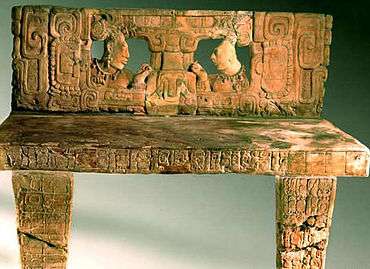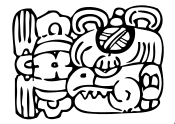K'inich Yat Ahk II
| K'inich Yat Ahk II | |
|---|---|
| Ajaw of Piedras Negras | |
|
K'inich Yat Ahk II's glyph, from Stela 15 | |
| Reign | 781–808 AD |
| Predecessor | Ha' K'in Xook |
| Father |
Itzam K'an Ahk II? T'ul Chiik? |
| Mother | Lady Bird |
| Religion | Maya religion |
K'inich Yat Ahk II (Mayan pronunciation: [kʼinitʃ jat akh]), also known as Ruler 7, was the last ajaw of Piedras Negras,[1] an ancient Maya settlement in Guatemala. He ruled during the Late Classic Period, from 781 to roughly 808 AD. Possibly a descendant of Itzam K'an Ahk II, K'inich Yat Ahk II ascended the throne upon the death of his brother, the sixth ajaw of the site, Ha' K'in Xook. While K'inich Yat Ahk II presided over the destruction of the rival Maya site Pomona, his reign seems to have ended with the capture of Piedras Negras by K'inich Tatbu Skull IV of Yaxchilan. Itzam K'an Ahk II left behind several monuments, including stelae at Piedras Negras, a stone seat known as Throne 1 which records either the death or abdication of Ha' K'in Xook, and Panel 3 which recounts the exploits of Itzam K'an Ahk II.
Biography
Reign of Piedras Negras
The last ruler of Piedras Negras, K'inich Yat Ahk II, also known as Ruler 7, was the son of Lady Bird, and was born on April 7, 750 AD (9.15.18.16.7 12 Manki' 5 Sotz' in the Long Count).[2] It is possible that he was the son of Itzam K'an Ahk II,[2] or perhaps T'ul Chiik, a prince of Piedras Negras.[1] The ruler's name is a combination of two elements: a title and a predecessor's name. The title, k'inich, translates to "red-faced", and is a reference to the settlement's rulers' belief that they were lords of the sun. The name portion, Yat Ahk, was not taken from one of K'inich Yat Ahk II's immediate predecessors, but rather from the Early Classic ruler of Piedras Negras, Yat Ahk I.[3][4] K'inich Yat Ahk II took up the throne at Piedras Negras on May 31, 781 (9.17.10.9.4 1 K'an 7 Yaxk'in), almost a year following the death of his brother, Ha' K'in Xook. Despite this lengthy gap, there appears to be no evidence of anyone ruling Piedras Negras between the two rulers.[5]
Acts of aggression
K'inich Yat Ahk II first moved against his opponents in August of 787 AD, capturing a yajaw k'ahk, or "lord of fire" from Santa Elena Poco Uinic.[2] Then, in both 792 and 794 AD, K'inich Yat Ahk II carried out two "star wars", or wars planned to coincide with key astronomical events, against the rival Maya settlement Pomona, the latter of the two resulting in a decisive defeat of Pomona.[2] K'inich Yat Ahk II was aided in both of these Pomona wars by his ally, Parrot Chaak of La Mar.[2][6]
Capture
K'inich Yat Ahk II's rule came to an end when Piedras Negras was captured by K'inich Tatbu Skull IV, the last king of Yaxchilan, in 808 AD; Lintel 10 at Yaxchilan directly names K'inich Yat Ahk II as a captive of the Yaxchilan ajaw.[2] There is evidence that troops from Yaxchilan attacked Piedras Negras and razed it, as several willful burnings have been documented around the site, and Throne 1 was deliberately dismantled.[2] In the 1930s, certain researchers used these signs as evidence that the site had undergone a "peasants revolt" but this idea has largely been rejected by contemporary scholars.[2] Regardless, Simon Martin and Nikolai Grube, and Mayanist Stephen D. Houston argue that the Piedras Negras dynasty may have survived after the capture and death of K'inich Yat Ahk II until c. 810 AD. Afterwards, however, the center collapsed and Piedras Negras was abandoned.[2][7]
Monuments
 |
| Maya civilization |
|---|
| History |
| Preclassic Maya |
| Classic Maya collapse |
| Spanish conquest of the Maya |
Stelae
Several stelae have been found that were erected by K'inich Yat Ahk II, including Stelae 12 and 15, which were sculpted out of limestone.[8] The first of these to be erected was Stela 15, which celebrated K'inich Yat Ahk II's first hotun ending while ajaw of Piedras Negras. The monument was positioned on the upper terrace of Pyramid O-13, where, as Megan O'Neil notes, the living king would have stood.[5] Stela 15 is innovative, because it depicts the leader in the round, making it an almost three-dimensional sculpture.. This innovation was the result of the sculptors fine-tuning their technical skills, and the stela marked "the closest [the sculptors of Piedras Negras] came to releasing the body from the stone block", according to O'Neil.[8] The monument bears some similarities to Ha' K'in Xook's Stela 13, as both show the ajaw holding a bag, and both feature an ajaw period-ending date. The installation of Stela 15 above Stela 13 and on the northwestern side of Pyramid O-13 was probably done to create a physical association with Ha' K'in Xook and Itzam K'an Ahk II.[5]

The final stela to be erected was Stela 12.[5] This monument details K'inich Yat Ahk II's aforementioned victory over Pomona; the imagery employed on the stela, more akin to carvings found on panels at Piedras Negras, shows K'Inich Yat Ahk II above military leaders and captives.[9][10] According to O'Neil, the relief's style is evidence that "the sculptors … favored multi-figural pictorial narrative over the divine ruler's singular embodiment or three-dimensional presence."[10] Houston and his colleagues argue that this stela is a "monument of vengeance", rectifying the defeat of Piedras Negras at the hands of Pomona in 554 AD.[9] While the monument is not a niche stela, it makes reference to the style by showing the seated ajaw at the top, and other people at the bottom, similar to Stelaes 4e 14 and 33. Stela 12 itself is aligned with Stela 14, a niche monument installed by Yo'nal Ahk III, and thus the theory that Stela 12 was purposely emulating the niche style gains more ground. The stela also faces southwest, but this is a consequence of the monument having been installed on the O-13 pyramid, which already faced southwest. O'Neil has proposed, however, that the orientation was also purposeful, and that K'inich Yat Ahk II was trying to connect his stela with the stelae of other, earlier rulers.[10] The state of the stela is relatively poor, and it has been highly eroded in several places. The stela is also of note because it lists several of the prisoners' names.[11]
When juxtaposed together, Stelae 15 and 12 offer up two images of a what it means to be a genuine king. Stela 15 shows K'inich Yat Ahk II as a devout practitioner of religious rituals, doing his sacred duty. On the other hand, Stela 12 shows the ajaw as a victorious military chief, defeating enemies and taking captives. O'Neil argues that their presence on the upper terrace of the O-13 pyramid is similar to how the images of previous kings of Piedras Negras were serialized.[10] In addition, both Stelae 15 and 12 include the names of several sculptors and artists, one of whom worked on both stelae.[10][11] These names are difficult to translate because many are unique when compared to extant Mayan glyphic texts.[11]
Throne 1

K'inich Yat Ahk II also commissioned the construction of Throne 1,[12][nb 1] which details either the death or abdication of Ha' K'in Xook.[12] All parts of the throne were covered in carved images and glyphs, and the back of the main panel features a zoomorphic face with human heads as eyes.[14] The throne was located in a special recess found in J-6, a gallery wing of the main Piedras Negras palace acropolis.[2] The throne was later deliberately broken apart by Piedras Negras's enemies, but has since been reconstructed.[12] As mentioned above, the destruction of this throne was used by some anthropologists to argue that Piedras Negras had been abandoned during a revolt.[2] J. Eric S. Thompson, on the other hand, proposed three theories concerning the destruction of Throne 1: that it had been destroyed in a peasant revolt, that invaders had smashed it, or that its destruction "was more recent and is attributable to superstitious fear".[15]
Lintel 3
K'inich Yat Ahk II also commissioned the carving of Lintel 3, which was placed on the O-13 Pyramid.[16] The lintel is both an intricate narrative of daily life in the palace, as well as a documentation of the 749 AD K'atun jubilee, which had been celebrated by Itzam K'an Ahk II.[16][17] According to the artifact, the celebration was attended by many dignitaries, including local nobles such as a b'aah sajal named K'an Mo' Te' who had served K'inich Yo'nal Ahk II, as well as the "interregnum" ruler of Yaxchilan, Yopaat Bahlam II. According to Martin and Grube, the importance of Panel 3 is its relevance to Piedras Negras's history. At the time, the Maya center had fallen behind when compared to Yaxchilan. As such, K'inich Yat Ahk II's erection of the lintel seems to be an attempt by the ajaw to harken back to a time when Piedras Negras was in a position of superiority.[16] To this day, many archaeologists and Mayanists consider Panel 3 to be a masterpiece of Maya art due to it elucidating the life of Itzam K'an Ahk II and his servants, as well as providing information regarding rare grammatical structures in the Mayan glyphs.[16][17]
Notes
- ↑ Due to Parrot Chaak's name appearing on the back of Throne—being "a literal supporter of the king"—Houston proposed that the artifact may have been commissioned by the La Mar leader and given to K'inich Yat Ahk II as a gift.[13]
References
- 1 2 "Piedras Negras Ruler 7". Mesoweb Encyclopedia. Retrieved February 6, 2014.
- 1 2 3 4 5 6 7 8 9 10 11 Martin & Grube 2000, pp. 152–153.
- ↑ O'Neil 2014, p. 147.
- ↑ O'Neil 2014, p. 9.
- 1 2 3 4 O'Neil 2014, p. 142.
- ↑ "Pomona". Mesoweb Encyclopedia. Retrieved February 6, 2014.
- ↑ Houston, Stephen (1999). "Among the River Kings: Archaeological Research at Piedras Negras, Guatemala". Mexicon. 22 (1): 8–17.
- 1 2 O'Neil 2014, pp. 87–88.
- 1 2 Houston, Stephen; Escobedo, H.; Child, M.; Golden, C.; Terry, R.; Webster, D (2000). "In the Land of the Turtle Lords: Archaeological Investigations at Piedras Negras, Guatemala". Mexicon. 22 (5): 97–110.
- 1 2 3 4 5 O'Neil 2014, p. 145.
- 1 2 3 Nelson, Zachary (May 2005). "Settlement and Population at Piedras Negras, Guatemala" (PDF). The University of Pennsylvania. pp. 171–186. Retrieved February 21, 2014.
- 1 2 3 Pitts, Mark (2011). "A Masterpiece of Maya Art". A Brief History of Piedras Negras as Told by the Ancient Maya: History Revealed in Maya Glyphs (PDF). University of Pennsylvania. pp. 162–170. Retrieved March 2, 2014.
- ↑ Houston 2004, p. 271.
- ↑ O'Neil 2014, p. 19.
- ↑ O'Neil 2014, p. 49.
- 1 2 3 4 Martin & Grube 2000, p. 149.
- 1 2 Pitts, Mark (2011). "Palace Life". A Brief History of Piedras Negras as Told by the Ancient Maya: History Revealed in Maya Glyphs (PDF). Pre-Columbian Society of the University of Pennsylvania Museum. pp. 129–145. Retrieved March 2, 2014.
Bibliography
- Martin, Simon; Grube, Nikolai (2000). Chronicle of the Maya Kings and Queens. Thames & Hudson. ISBN 9780500051030.
- O'Neil, Megan (2014). Engaging Ancient Maya Sculpture at Piedras Negras, Guatemala. University of Oklahoma Press. ISBN 9780806188362.
